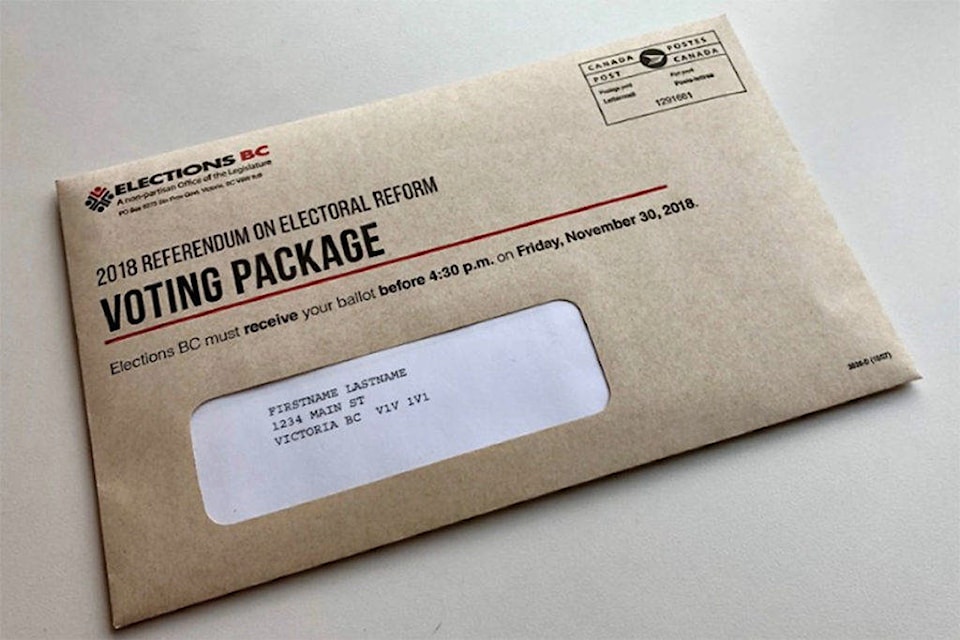A Surrey BC Liberal MLA says the level of response to the ongoing provincial referendum to date is “really scary” – on an issue she describes as “the most important question the electorate can be asked.”
Surrey South MLA Stephanie Cadieux said she puts a caveat on her proportional-representation turnout opinion, noting the ongoing postal strike meant some residents received their voting packages after Nov. 2.
“It’s still very concerning at this stage of the game, halfway into the referendum, we have two per cent of ballots returned,” Cadieux told Peace Arch News Wednesday.
PAN reported this week that just 14 ballots from Surrey/White Rock – out of more than 42,000 – had been returned to Elections BC as of last Friday.
READ MORE: Just 1% of B.C. has voted in electoral referendum
NDP MLA Jinny Sims (Surrey-Panorama), however, said it is premature to worry about turnout. She said she, too, is among those who have yet to return their ballot.
“It’s early,” she said. “I’ll be voting this weekend. Those who want to vote will vote.”
Residents across B.C. have until Nov. 30 to choose either to stay with the first-past-the-post system or transition to proportional representation. On the ballot, those who vote yes to a switch may also choose from three types of proportional representation: dual-member proportional, mixed-member proportional or rural-urban proportional.
PAN reached out to Cadieux and Simms, after Surrey-White Rock BC Liberal MLA Tracy Redies Redies distributed her opinion on the referendum by email.
In last week’s email, Redies describes the issue as “complex with significant implications,” and says the decision to draft the questions – rather than have an independent citizens assembly do so – is one that left the process open to political influence.
But Sims said the criticism – which includes the suggestion that proportional representation allows “special-interest parties to be elected with very little support” – is “fear-mongering.”
“I just have to look to the south, that’s first-to-the-post. They ended up with Trump,” Sims said. “The foundational piece it comes down to is do you believe in your legislature reflecting the population, and if you do, vote for proportional representation.”
READ MORE: Threat of extremism posed by proportional representation overstated: academics
Sims said she is “surprised at the angst that the Liberals have worked themselves up about” around the referendum, noting their party promised to raise the issue.
Cadieux said she is not opposed to a referendum on the voting system, but is “dissatisfied with the process this time.” She said it asks a vague question, with 29 details to be determined after-the-fact, essentially “giving a blank cheque to the government” if passed.
“I am frustrated by it. It was done in a hurry, it was done without the proper process.”
Cadieux said she is not convinced voters understand the question.
She voted Tuesday (Nov. 13) to stick with the current first-past-the-post system, because “I know what I’m getting as a voter.”
“For all its faults, I understand it,” Cadieux said.
Redies noted in her email update that two of the three proportional representation systems on the ballot have not been used anywhere else, “meaning there is no evidence of how they work in the real world.”
Proportional representation in any form, she said, leads to larger constituencies and a loss of local representation, and can decrease accountability.
Sims countered that it “means every vote counts and that different parties have to work together.”
She said she has not yet decided which proportional representation systems she prefers, but added “any one of the other three is better than what we have now.” The ballot, Simms noted, “doesn’t say you have to answer both questions.”
“By the time I vote, maybe I’ll have landed on one. Right now, all three look good.”
The referendum will be the third such vote in 18 years. In 2005, 57 per cent of voters chose proportional representation, and in 2009, just 39 per cent of voters were in favour. In those, a 60 per cent majority was required for the referendum to pass.
Cadieux and Sims both encouraged residents to cast their votes. Cadieux cautioned voters that the Nov. 30 deadline to return ballots is not a “post-marked-by” target. The ballots must be received by that date, but “unless people read the fine details, they wouldn’t necessarily know that,” she said.
Redies encouraged voters to “make sure you’re informed,” as the referendum “requires just a 50-per-cent-plus-one majority to pass, with no minimum voter turnout.”
“Essentially, if 10 per cent of British Columbians vote and 5 per cent plus one vote for PR, we are changing our entire voting process,” she said.
